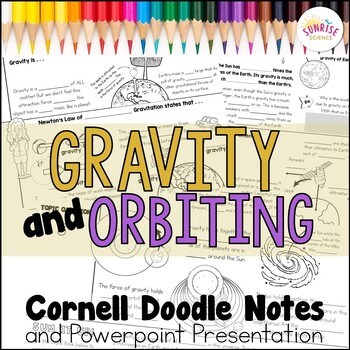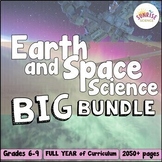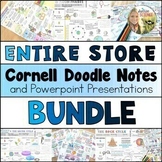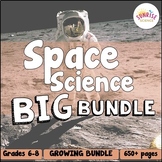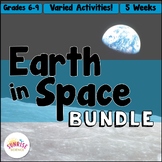Gravity & Orbiting Doodle Notes | Orbital Motion | Solar System | Middle School
- PDF
What educators are saying
Also included in
- This is a bundle of all of my resources for teaching Earth and Space Science at the middle school level! These resources include a mix of Cornell Doodle Notes, lab activities, inquiry activities, digital lessons and units, projects, and pixel art digital content review activities.✨ Please note thatPrice $327.00Original Price $450.24Save $123.24
- This is a growing bundle of all of my Cornell Doodle Notes on Earth and Space Science topics. This resource currently contains Cornell Doodle Notes, the associated Powerpoint / Google Slides Presentations, and (for most) Google Slides versions of the notes for 16 topics.The topics currently includedPrice $64.00Original Price $80.76Save $16.76
- This is a growing bundle of ALL of my Science Cornell Doodle Notes resources. This bundle currently contains Cornell Doodle Notes and the associated Powerpoint / Google Slides Presentations for 48 science topics. The price at this point reflects what is in the bundle at this time, plus 20% off. As aPrice $189.00Original Price $244.25Save $55.25
- This is a bundle of all of my resources for teaching Space Science at the middle school level! These resources include a mix of Cornell Doodle Notes, lab activities, inquiry activities, digital units with assessments, projects, and pixel art digital content review activities.Receive 25% off this BIGPrice $97.00Original Price $129.34Save $32.34
- Looking for fun, student-centered, and engaging activities to teach about Earth's rotation and revolution, the reason for the seasons, moon phases, gravity and orbiting, solar and lunar eclipses, and the planets and other objects of our solar system?Using all of the resources in this bundle will givPrice $67.00Original Price $85.34Save $18.34
Description
These scaffolded, no-prep Gravity and Orbiting Cornell Doodle Notes can be used to teach about how weight is a measure of the force of gravity acting on a mass. Students are introduced to the concept of gravity as an attraction force between all matter in the universe and that gravity is affected by both mass and distance., the change in an object’s weight depending on the body it’s on, the concept of an object orbiting around a larger object in space and what a satellite is, and the role of gravity as a force that holds together the solar system and the galaxy.
Seamlessly deliver the scaffolded versions to your class so each student gets notes at his or her level -- it's the same content but different amounts of writing. You can use these notes in a whole-class lecture format with the presentation, or post the presentation to your Google Classroom and have students complete the notes individually or in pairs!
These notes were designed to align with NGSS Standards MS-ESS1-2 (Develop and use a model to describe the role of gravity in the motions within galaxies and the solar system. Emphasis for the model is on gravity as the force that holds together the solar system and Milky Way galaxy and controls orbital motions within them.) and MS-PS2-4 (Construct and present arguments using evidence to support the claim that gravitational interactions are attractive and depend on the masses of interacting objects.).
Cornell Notes are a note-taking strategy in which topic questions are written in a narrow left-hand column and definitions, explanations, and diagrams are filled in in the right-hand column.
Doodle Notes are another note-taking strategy for which pictures and graphics activate the visual pathways of the brain, which helps with retention of information when compared to standard note-taking. Your visual learners will really benefit from seeing and coloring in the pictures aside the main points of the notes!
What's Included (please see the preview also!):
- The Cornell Doodle Notes are 3-pages each and there are 3 scaffolded versions
- Colored Answer Key
- Two presentation options: Powerpoint AND Google Slides
Here are some ways that I suggest using this resource:
✎ Whole-Group lesson with scaffolding : Decide which students should receive which level of the notes. Hand out the notes to the students. Use the Powerpoint or Google Slides as a presentation and talk aloud through the lesson while the students take notes OR If you have a document camera (an ELMO), you can fill out your own notes and the students can follow along with you as you discuss the concepts aloud! Stop throughout the lesson to have the students pair-share and discuss what they are learning. Allow them to color/doodle further during and at the end of the lesson.
✎ Scaffolded Small-Group lesson : Separate your students into groups by learning level. Give each student group sets of the appropriate notes for their level. Make sure each group has a device to view the presentation. Post the Powerpoint or Google Slides to your Google Classroom or other online learning platform, or email the Powerpoint version to one ‘student leader’ in each group. The students would view the Powerpoint/Slides together on one device and fill in the notes. Encourage them to add color/further notes.
✎ Individual Note-Taking or Flipped Classroom : Post the Powerpoint or Google Slides presentation to your Google Classroom or other online learning platform. Hand out the appropriate-level notes to each student. Students can work at their own pace to view the presentation and complete their notes. Encourage them to add color/further notes. Could also be assigned for homework or as a “half & half lab” for which one group of students is taking notes at their desks while another group is performing a lab.
Please note that this resource is not editable due to font and clip art licensing agreements and also to protect my work. However, you can always add additional text boxes to the presentation, as well as insert new slides with images/text/video clips, etc. to customize the lesson for you and your students!
Doodle notes is a trademarked term used with permission. Please visit doodlenotes.org for more information.
If you are teaching a unit on Space, you may also be interested in these resources:
The Universe and Its Stars Unit
Hubble Space Telescope Scavenger Hunt
Thanks for looking!
Sunrise Science

